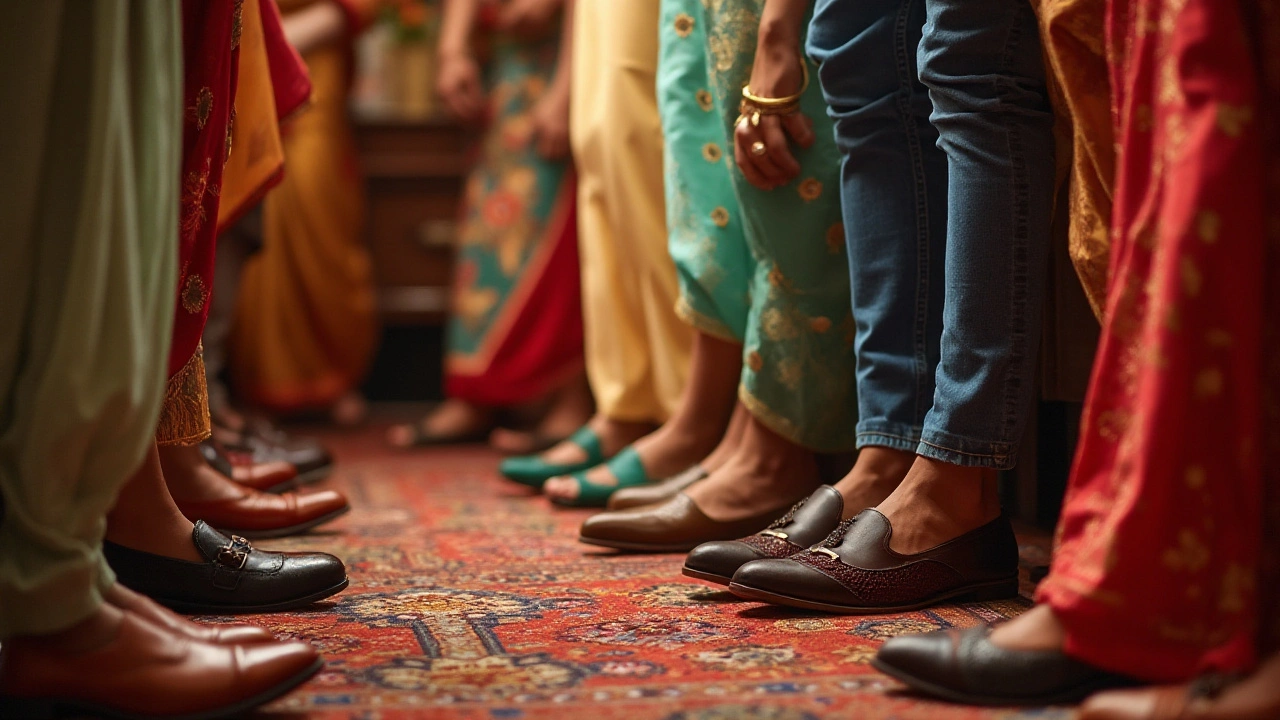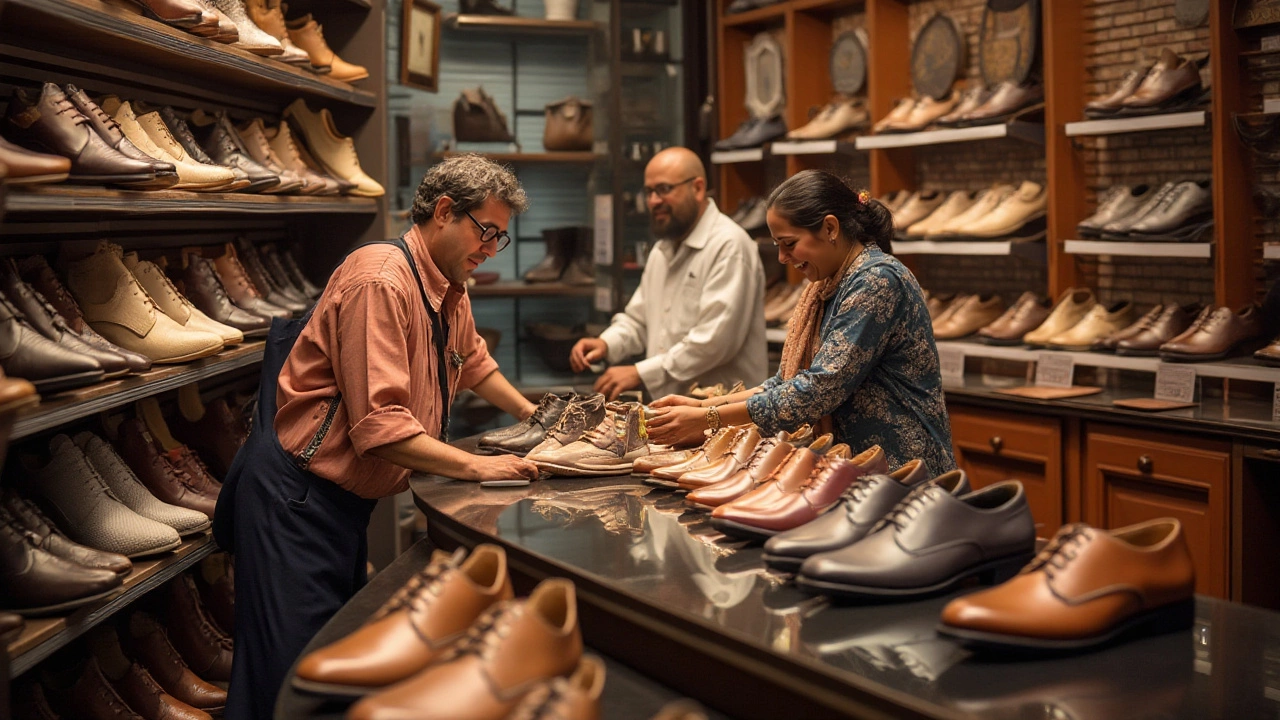When it comes to footwear, those of us with difficult feet know that the struggle is real. We've all been there, right? Standing in the shoe aisle, juggling fashion with function, and hoping to find that perfect pair. Leather shoes often make the shortlist thanks to their durability and timeless appeal, but the key is finding a brand that doesn't sacrifice comfort for style.
Bad feet deserve tender loving care, and that means choosing wisely when it comes to shoes. A good pair of leather shoes that prioritizes foot wellness can make all the difference in the world for your day-to-day comfort. Let's explore some of the top brands that not only look great but also feel like a dream. Whether you're on your feet all day or looking for something to carry you through a night out, read on to find shoes that love your feet back.
- The Importance of Foot Health
- Key Features of Comfortable Leather Shoes
- Top Brands for Bad Feet
- How to Choose the Right Shoe
- Caring for Your Leather Shoes
- The Future of Comfortable Footwear
The Importance of Foot Health
Our feet carry us through life, often over rough terrains, plush carpets, and cobblestone streets, yet they are frequently overlooked in terms of health and care. Each foot is an intricate masterpiece of bones, joints, muscles, and tendons, designed to distribute weight and support movement. Neglect can lead to a cascade of problems, ranging from sore arches to debilitating joint pain. For those struggling with conditions like plantar fasciitis or flat feet, the choice of footwear becomes crucial. Foot problems don't simply stay in the lower extremities; they can migrate upward, affecting posture, spinal alignment, and even leading to knee and hip issues. Addressing foot health helps prevent these domino effects, ensuring that our movement remains fluid and pain-free.
The average person walks about 100,000 miles in a lifetime, which means the humble foot is under a considerable amount of stress. To manage this daily strain, proper shoe support becomes indispensable. High-quality leather shoes provide the necessary support, cushioning, and breathability needed for bad feet. Imagine walking a lifetime dealing with blisters, calluses, or misaligned toes simply because of poor shoe choices. Shoe brands that prioritize comfort recognize the foot's complex structure and create designs that cater to both style and orthopedic needs. This attention to both form and function is evident in how some brands incorporate arch support, heel stabilization, and padded insoles in their shoes.
According to the American Podiatric Medical Association, an estimated 77% of Americans have experienced foot problems, and improper footwear is often a significant contributor. It's crucial to be aware of your arches and how they align with the rest of your body. A shoe unfit for your foot can lead to long-term complications. Consequently, investing in well-made leather shoes not only enhances day-to-day comfort but also preserves foot health. Comfortable footwear is not just a luxury; it is a necessity. "Good shoes take you to good places," reads an old proverb, which underscores the importance of choosing wisely and valuing quality over quantity.
To put it into perspective, consider the fact that every pound of body weight places about five pounds of pressure on each foot joint. Now, picture wherein your leather shoes can distribute that load, offering the much-needed relief and balance. Brands that concentrate on ergonomic design leverage technology and research to produce shoes that maintain the natural arch and promote healthy foot posture. Foot health isn't a standalone entity; it intertwines with overall well-being, impacting everything from mood to mobility. It's about time we take a step forward in understanding and prioritizing foot health through the choices we make in our daily sartorial selections.
Key Features of Comfortable Leather Shoes
When you think about comfortable footwear, especially for those with problematic feet, there are several design elements that truly make a pair of leather shoes stand out. At first glance, you might only notice the sleek appearance of leather, but there's much more at play here. The blend of materials, the crafting techniques, and the anatomical support all contribute to making a shoe not just wearable, but genuinely comfortable for extended periods. For instance, a well-cushioned footbed often serves as the backbone of comfort, providing the soft support that arch and heel need. Moreover, a contoured footbed is essential for maintaining proper foot alignment, which can alleviate common issues such as plantar fasciitis or discomfort caused by flat feet.
The breathability of leather is another understated virtue that's vital for foot health. Quality leather allows the foot to breathe, providing a cooling effect and absorption of moisture, which helps in maintaining foot hygiene. Shoes equipped with moisture-wicking linings go a step further by keeping the interior dry and fresh. Additionally, durable outsoles crafted from rubber or synthetic blend materials offer excellent shock absorption and grip, essential for those who are on their feet all day or walking on uneven surfaces. The importance of shock absorption can't be overemphasized, as it protects the foot from sudden impacts, reducing strain on the joints and tendons.
The Role of Proper Fit
The best brands often accentuate the significance of fit. Adequate width options, combined with adjustable features such as velcro or lace-up systems, ensure that shoes accommodate different foot shapes. A narrow fit might squeeze uncomfortably, while too wide a shoe could lead to slipping and blisters. Customizable features like removable insoles further allow for personal adjustments, which can cater to individual orthotic needs. An ideal shoe respects the natural splay of the toes, with a generous toe box that doesn't cramp them. According to Dr. Andrew Schneider, a renowned podiatrist, "A shoe should fit the foot precisely, almost as if it were a custom-made glove."
When considering the stitching, well-constructed seams, often double or triple stitched, ensure that the shoe will withstand daily wear and tear. This kind of meticulous craftsmanship is typically found in high-end brands committed to quality. Many premium leather shoes also utilize Goodyear welting, a technique that not only enhances durability but also allows for resoles, extending the shoe's lifespan. And let's not overlook aesthetics—style is an innate part of comfort. A shoe that you enjoy wearing, because it looks good, often feels better just by virtue of fitting your personal taste.

Top Brands for Bad Feet
Finding the right leather shoes for uncomfortable feet isn't just about luck; it's about knowing which brands deliver comfort with every step. Among these standouts, Clarks has long been a reputable name in the footwear industry. Known for their meticulous craftsmanship, Clarks shoes are designed to provide relief and support, which is crucial for those dealing with foot pain. Their comfortable footwear often features cushioned insoles and flexible soles, making them a go-to for all-day wear. The brand’s commitment to combining traditional styles with modern comfort technology has surely positioned them as a leader for those in need of both flair and function.
Another top contender is the Ecco brand, celebrated for its innovation and use of durable materials. Ecco’s signature anatomical design aims to fit the natural curve of the foot, which can be a literal lifesaver for individuals with chronic foot ache. This Danish shoemaker prides itself on producing shoes that mirror the foot’s natural shape, providing a snug yet comfortable fit. Ecco’s technological advances in shock absorption and breathable materials make them a favorite among consumers looking for best brands for faulty feet.
If you're seeking an American-made solution, New Balance has extended its renowned athletic comfort into the world of leather shoes. While typically known for its sneakers, New Balance leather options come with the famous cushioned support and spacious toe boxes that are ideal for customers needing that extra room. The brand's leather line offers shoes that focus not only on the aesthetic but also on promoting healthy foot posture, reducing the chances of further foot complications.
Don’t overlook Rockport, a brand synonymous with combining formal style with athletic comfort. They've been crafting shoes that transition seamlessly from the office to an evening out, all while prioritizing foot wellness. With features like truTECH lightweight shock absorption and a range of width sizes, Rockport caters to individuals in search of stylish yet comfortable footwear.
Finally, if luxury speaks to you, Bally doesn't disappoint. This Swiss brand infuses class with comfort, offering leather shoes that cushion your steps while dressing you to the nines. With a legacy rooted in quality, Bally’s line incorporates padded insoles and a commitment to flexibility, ensuring even weight distribution across the foot. Their attention to detail in accommodating those with tender feet is rivaled by few in the industry. As a nod to their lasting impact, it was once stated by a prominent figure in fashion,
"Bally offers a luxe experience for your feet, ensuring not only style but also exceptional comfort."
How to Choose the Right Shoe
Selecting the perfect pair of leather shoes when plagued with bad feet is a task that requires more than a mere glance at the aesthetic appeal of leather shoes. There are several critical aspects to consider to ensure your footwear provides the necessary comfort and support. First, assess the arch support of the shoe. A well-designed insole with good arch support can make a world of difference by aligning the foot properly and reducing pressure on joints. Always try on the shoes at the end of the day when your feet are slightly swollen; this will give a more accurate fit. Remember, shoes that are too tight can prove disastrous, while shoes that are too loose can cause blisters and chafing. Pay special attention to the fit around the heel and the widest part of the foot, as these are key areas requiring adequate support and comfort.
Next, consider the construction of the shoe, particularly the materials used. Look for shoes crafted from high-quality leather that offer breathability and flexibility. Leather as a material naturally molds to the shape of your foot, providing a personalized fit over time. The sole is equally important; opt for a rubber or cushioned sole that promotes shock absorption with each step. Additionally, ensure the shoe has a good heel counter, which is the part that wraps around your heel to provide support. A strong heel counter helps maintain the integrity of the shoe and stabilizes your foot on uneven surfaces.
Another vital factor is the shoe's interior. Examine the footbed for cushioning, as it should offer a soft landing for your foot and support for prolonged wear. Removable insoles can be beneficial as they allow you to replace them with custom orthotics if necessary. The lining of the shoe should also be smooth and moisture-wicking to prevent friction and heat buildup during wear. Don't hesitate to walk around the store for a few minutes with both shoes on to test their comfort and support.
For a more personalized approach, consider seeking recommendations from a podiatrist. According to Dr. John Smith, a leading podiatrist, wearing shoes that are designed with comfortable footwear in mind is crucial for those with existing foot issues. He notes, "Choosing shoes that fit your foot shape and address any specific concerns can drastically reduce discomfort and the potential for injury." It’s worth investing time to explore a variety of brands and try multiple pairs before making a decision.
Lastly, lifestyle and intended use should influence your choice. If you are buying shoes for prolonged standing at work, select designs that offer extra cushioning and stability. Consider lace-up styles that allow adjustments for a more secure fit. On the other hand, if you're seeking shoes for leisure or special occasions, prioritize classy styles that don’t compromise on comfort. Keep your foot measurements in mind because they can change over time due to factors like age or weight gain, and sizes may vary between brands. Each step towards selecting the right pair of leather shoes contributes significantly to your foot's health and well-being. The benefits of choosing wisely extend beyond foot comfort—they can enhance your overall daily experience.

Caring for Your Leather Shoes
Leather shoes possess a unique charm that only gets better with age, if given the right care. Taking good care of your leather shoes is not just about extending their lifespan, but also about ensuring they remain as comfortable as the day you bought them. First and foremost, understanding the nature of leather is crucial. Leather is a natural material that breathes and adapts to the wearer's foot, but it can also be susceptible to damage from water, heat, and neglect. This is why maintaining a routine for shoe care is essential, despite any hectic schedules we might have.
Cleaning is the foundation of caring for leather shoes. It's not just about wiping them down occasionally. After each wear, especially when exposed to dirt or grime, gently brushing off surface dirt with a soft-bristled brush establishes a good basic level of care. For deeper cleaning, a good quality leather cleaner or saddle soap goes a long way, breaking down stubborn stains while preserving the integrity of the material. Following cleaning, moisturizing is vital. Leather can crack or stiffen without proper moisture. Using a leather conditioner nourishes the leather, allowing it to maintain its suppleness and comfort. Remember, leather is much like your skin; it appreciates care and attention.
Polishing is another crucial step, a bit like adding a touch of make-up, enhancing the leather’s natural glow and providing a layer of protection against the elements. Choose a color-matched polish to cover any minor scuffs. If you're going for a mirror shine, patience is key. Apply thin layers, allowing each to dry before buffing, which adds that distinguished shine. A paraffin wax-based polish usually does the trick and improves the leather’s ability to withstand moisture. Renowned British shoe manufacturer John Lobb has long been a stalwart in the shoe industry, famously noting that 'care is the art of keeping shoes alive.'
Storing your leather shoes correctly is equally important. Avoid tossing them into the bottom of a closet. Instead, insert cedar shoe trees when they aren't being worn. The shoe trees will help your shoes maintain their shape, and the cedar acts as a natural deodorizer, absorbing moisture and preventing odors. Storing leather shoes in a dry, cool place keeps mold at bay. Avoid exposing them to direct sunlight or heat sources as this can lead to cracking and fading.
Beyond cleaning, regular conditioning, and polishing, occasionally, a professional overhaul might be warranted. Depending on the amount of use, taking them to a cobbler for a professional shine or re-soling should not be overlooked. This can breathe new life into the shoes, especially for those who spend much of their time on their feet. Having a great pair of leather shoes is a worthy investment, and caring for them ensures they serve you well for years down the line. So, when you slip into them, and they fit like they are an extension of your being, a combination of science and a little luxury, you'll know your efforts have paid off.
